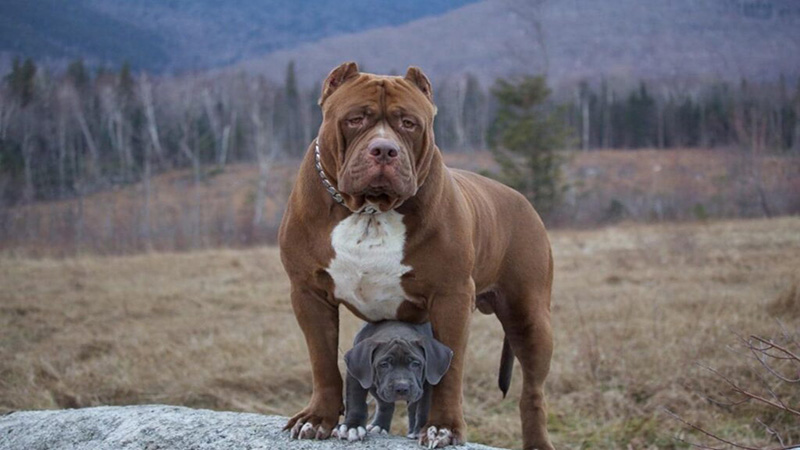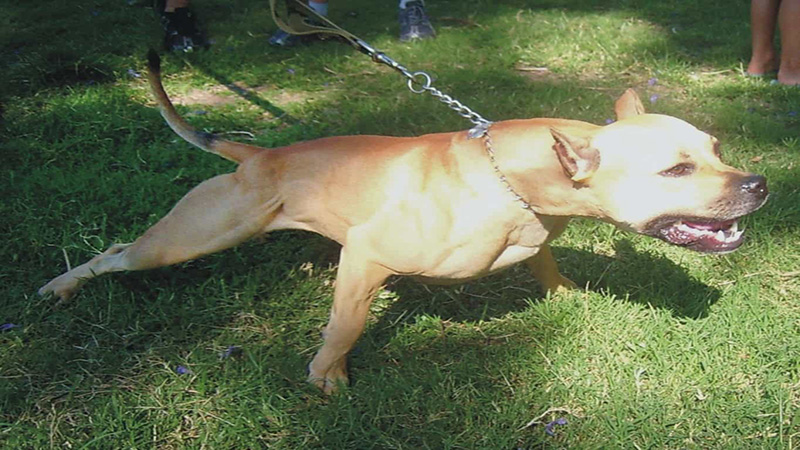Each dog will have different characteristics and habits, so their care will certainly differ. To learn more about how to raise a healthy Pitbull, follow this article!
1. Get to Know the Pitbull Breed
Origin of the Pitbull
The Pitbull is known for its English origin, having been brought over to America. This breed has a fierce appearance, with a muscular build, a stoic demeanor, and a sturdy frame. Pitbulls are commonly used as guard dogs, pets, or hunting companions.
 Pitbull Dog
Pitbull Dog
Physical Characteristics of the Pitbull
Pitbulls are medium-sized dogs, standing at about 50 cm tall and weighing between 15-30 kg. They have short coats, characteristic curled tails, and distinctive bowed legs.
Temperament of the Pitbull
Pitbulls are known for their aggressive nature, with a formidable appearance, sharp teeth, and menacing red eyes. As a result, Pitbulls are considered one of the most dangerous dog breeds to humans.
Types of Pitbulls
There are four common types of Pitbulls:
American Pit Bull Terrier: This type of Pitbull has the most proportionate body, standing between 43-53 cm tall and weighing around 15-30 kg. They have almond-shaped eyes and short, cropped ears.
 American Staffordshire Terrier
American Staffordshire Terrier
Staffordshire Bull Terrier: This breed originates from the Staffordshire region in England.
 Staffordshire Bull Terrier
Staffordshire Bull Terrier
American Bully: This breed is a cross between the American Bulldog and the Pitbull.
 American Bully
American Bully
For further reference:
2. How to Care for a Pitbull
Pitbull Diet
Nutritional Requirements for Pitbulls by Age
Pitbulls aged 2-4 months:
At this age, puppies are just starting to eat solid food, and their digestive system is still developing. Therefore, offer soft, easily digestible food. Avoid raw foods as they can upset their stomachs.
Pitbulls aged 4-6 months:
During this phase, increase their protein intake with various meats, reduce carbohydrates, and feed them about 3-4 times a week.
Remember not to overfeed fatty foods to prevent obesity, and you can give them soft bones like chicken necks to exercise their jaws.
Pitbulls over 6 months old:
 Pitbulls over 6 months old
Pitbulls over 6 months old
Once they reach this age, their digestive system is more stable and developed, so you can introduce raw meats and fresh foods into their diet. Reduce their meals to twice a day, and it’s best to limit carbohydrates and fats while increasing protein and calcium for energy and strong bones.
Detailed Menu for Pitbulls
- For Pitbull puppies, provide food that amounts to 10% of their body weight per day. For example, a 10 kg Pitbull should be fed a minimum of 1 kg of food per day, divided into 3-4 meals.
- For adult Pitbulls, the daily food intake should be equivalent to 7-8% of their body weight. A 30 kg Pitbull should be fed a minimum of 1.5 kg of food per day, divided into 2 meals. Pitbulls love beef and can eat up to 1.5-2 kg per day.
Grooming and Hygiene for Pitbulls
Ensure your Pitbull has a nutritious diet, with meals spaced about 5 hours apart. In addition to their regular food, you can supplement their diet with dog-specific nuts and seeds.
 Grooming and Hygiene for Pitbulls
Grooming and Hygiene for Pitbulls
For hygiene, bathe your dog about 2-3 times a month using dog-specific shampoo to protect their sensitive skin. Regularly clean their skin to prevent parasitic and fungal infections. Also, remember to vaccinate your dog to prevent common canine diseases.
Common Health Issues in Pitbulls
Pitbulls are prone to congenital heart defects, dysplasia, thyroid disorders, cerebellar ataxia, knee injuries, and serious health issues like skin allergies, urinary tract infections, autoimmune diseases, and joint problems as they age.
Things to Keep in Mind When Owning a Pitbull
 Things to Keep in Mind When Owning a Pitbull
Things to Keep in Mind When Owning a Pitbull
When owning a Pitbull, keep in mind the following:
- If you have young children, consider another breed as Pitbulls can be aggressive and may pose a risk to kids.
- Always use a muzzle and keep them in a secure enclosure to prevent any potential harm to others.
- Socialize and train your Pitbull from a young age to curb their aggressive tendencies.
Tips for Feeding Your Pitbull
When deciding what to feed your Pitbull, keep the following in mind:
- Wash their food and water bowls before and after each meal.
- Do not feed them leftovers from previous meals, especially spoiled or expired food.
- Vary their diet. Do not rely solely on dry food for an extended period.
- Do not let them go too long without eating to avoid overeating. Serve their food at room temperature.
- Adult Pitbulls can benefit from raw foods to encourage chewing and jaw development.
 Tips for Feeding Your Pitbull
Tips for Feeding Your Pitbull
3. Tips for Buying a Pitbull
Pitbull Price Range
The price of a Pitbull depends on its origin and lineage.
| Origin of the Pitbull | Price Range |
| Purebred Pitbull, locally bred in Vietnam | From 6 to 8 million VND |
| Pitbull imported from Thailand | From 10 to 15 million VND |
| Purebred Pitbull imported from America | From 50 to 60 million VND |
| Purebred Pitbull imported from America with a champion bloodline | From 100 to 120 million VND |
Things to Consider When Buying a Pitbull
Given the high price tag, here are some things to keep in mind when purchasing a Pitbull:
- If you’re not experienced, bring along someone knowledgeable about Pitbulls when making a purchase.
- Choose a dog with a healthy physique and no apparent health issues.
- Spend about 25-30 minutes playing with the dog to assess its temperament before buying.
- Opt for a puppy between 2-3 months old; avoid buying an older dog.
That concludes our guide on the Pitbull breed. If you’re still undecided about which dog to choose and how to care for it, consider the fascinating world of Pitbull ownership!
You may also like:

































